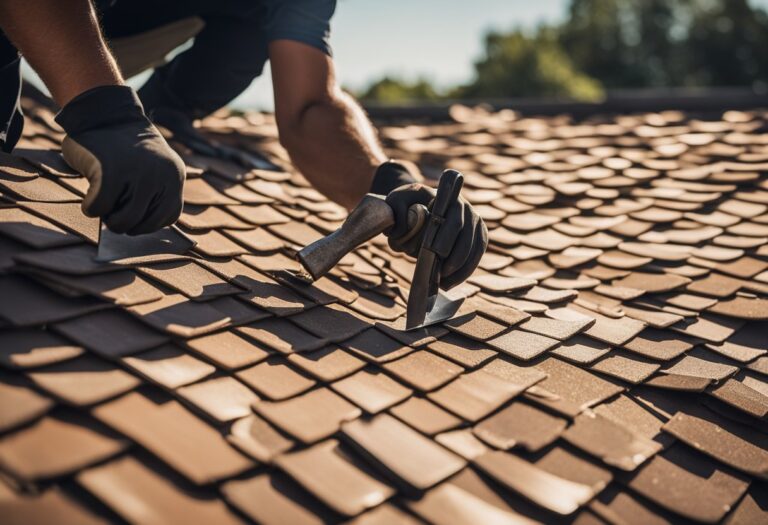Roofing nails are an essential component of any roofing project. They are used to secure shingles, tiles, or other roofing materials to the roof deck. Roofing nails come in different sizes, materials, and shapes, and choosing the right type of nail is crucial for the success and longevity of a roofing project.

One of the most important factors to consider when choosing roofing nails is the material. Common materials for roofing nails include aluminum, stainless steel, galvanized steel, and copper. Each material has its own unique properties, and some are more suitable for certain roofing materials than others. For example, copper roofing nails are ideal for slate roofing, while galvanized steel nails are commonly used for asphalt shingles.
Another factor to consider when choosing roofing nails is the size and shape. Roofing nails come in different lengths, gauges, and head shapes, and each type is designed for a specific task. For instance, longer nails are used for thicker roofing materials, while shorter nails are used for thinner materials. Similarly, nails with larger heads are used for securing heavier materials, while nails with smaller heads are used for lighter materials.
Types of Roofing Nails

Roofing nails are a crucial component of any roofing project. They are used to attach shingles, tiles, or other roofing materials to the roof deck. There are several types of roofing nails available in the market, each with its own unique features and benefits. In this section, we will discuss the two main categories of roofing nails: material varieties and size and gauge options.
Material Varieties
Roofing nails are made from various materials, including aluminum, copper, stainless steel, and galvanized steel. Each material has its own advantages and disadvantages, and the choice of material depends on the type of roofing material being installed, the climate, and the budget.
- Aluminum Nails: These nails are lightweight, affordable, and resistant to rust and corrosion. They are best suited for asphalt shingles and other lightweight roofing materials.
- Copper Nails: Copper nails are durable, strong, and resistant to corrosion. They are ideal for slate, tile, and cedar roofing materials. However, they are more expensive than other types of roofing nails.
- Stainless Steel Nails: Stainless steel nails are corrosion-resistant and strong. They are suitable for all types of roofing materials, including asphalt shingles, metal roofing, and tile. They are more expensive than galvanized steel nails but are worth the investment in harsh climates.
- Galvanized Steel Nails: Galvanized steel nails are coated with zinc to prevent rust and corrosion. They are affordable and ideal for asphalt shingles and other roofing materials. However, they may not be suitable for areas with high humidity or coastal regions.
Size and Gauge Options
The size and gauge of roofing nails are essential factors to consider when choosing the right type of nail for a roofing project. The size of the nail refers to its length, while the gauge refers to its thickness. The size and gauge of the nail depend on the roofing material being installed, the pitch of the roof, and the local building codes.
- Length: The length of the nail depends on the thickness of the roofing material and the roof deck. The most common lengths for roofing nails are 1-1/4″, 1-1/2″, and 1-3/4″. However, longer nails may be required for thicker roofing materials or multiple layers of shingles.
- Gauge: The gauge of the nail refers to its thickness. The most common gauges for roofing nails are 11, 12, and 13. The higher the gauge number, the thinner the nail. Thicker nails are stronger and more durable, but they may not be suitable for all roofing materials.
In conclusion, choosing the right type of roofing nail is crucial for the success of a roofing project. The material and size of the nail depend on various factors, including the roofing material, climate, and local building codes. It is essential to consult with a roofing professional to ensure that the right type of nail is used for the project.
Installation Techniques

Proper Nail Placement
When it comes to roofing, proper nail placement is crucial to ensure the shingles stay securely in place. The nails should be driven into the shingle’s nailing strip, which is a reinforced area designed to withstand the force of the nail. The nailing strip is typically located 1/2 inch above the bottom edge of the shingle and 1-1/2 inches in from the side edge.
Using the right length of nails is also important. According to IKO, the nail should penetrate at least 3/4 inch into the roof deck. However, if the deck is thicker than 3/4 inch, a longer nail should be used. Using nails that are too short can result in the shingles coming loose or blowing off in high winds.
Nail Gun Usage
Nail guns can be a time-saving tool when it comes to roofing installation, but they must be used correctly to avoid damaging the shingles. The pressure on the nail gun should be set correctly to ensure the nail is driven in with enough force to hold the shingle in place, but not so much force that it damages the shingle.
It is also important to use the right type of nail gun and nails. According to Anchor Point Roofing, a coil nail gun is best for roofing installation because it can hold more nails and requires fewer reloads. The nails used in the gun should be the correct length and have a smooth shank, which will provide better holding power than nails with rings or barbs.
In summary, when installing roofing, it is important to ensure proper nail placement and use the correct length and type of nails. Nail guns can be a helpful tool, but they must be used correctly to avoid damaging the shingles.
Common Applications

Roofing nails are used to attach roofing materials to a building’s roof decking or sheathing. They come in different types and sizes to suit various roofing applications. In this section, we will discuss the common applications of roofing nails in three main roofing materials: asphalt shingles, metal roofing, and tile and slate.
Asphalt Shingles
Asphalt shingles are the most popular roofing material in North America. They are lightweight, durable, and easy to install. Roofing nails are used to secure the shingles to the roof decking. According to IKO, 12-gauge roofing nails are the minimum thickness allowed by most building codes in North America. However, some codes allow 11- or 10-gauge nails, which are thicker and sturdier.
To install asphalt shingles, roofers typically use four to six nails per shingle, depending on the manufacturer’s instructions or local codes. The nails should be driven flush with the shingle surface but not overdriven, which can damage the shingle.
Metal Roofing
Metal roofing is a popular choice for commercial and residential buildings. It is durable, fire-resistant, and energy-efficient. Metal roofing panels are attached to the roof decking with roofing screws or nails. According to The Spruce, roofing nails for metal roofing should be made of stainless steel or other corrosion-resistant materials to prevent rust and corrosion.
Roofing nails for metal roofing come in different lengths, depending on the thickness of the metal panels. The nails should be long enough to penetrate the roof decking but not too long to damage the underside of the panels. Roofers should also use neoprene washers or other sealing materials to prevent water infiltration around the nail holes.
Tile and Slate
Tile and slate roofing are popular in areas with a Mediterranean or Spanish architectural style. They are heavy, durable, and fire-resistant. Roofing nails for tile and slate roofing are typically made of copper or stainless steel to prevent corrosion.
Roofers should use special roofing nails with wide flat heads and long shanks to secure the tiles or slates to the roof decking. The nails should be driven through the pre-drilled holes in the tiles or slates and into the roof decking. The heads of the nails should be flush with the surface of the tiles or slates to prevent water infiltration.
Performance Factors

When it comes to roofing nails, there are two main performance factors to consider: corrosion resistance and holding power.
Corrosion Resistance
Corrosion resistance is a critical factor in determining the lifespan of a roof. Nails that are not resistant to corrosion will rust and weaken over time, leading to premature failure of the roof. Therefore, it is important to choose roofing nails that are made from materials that are resistant to corrosion.
Galvanized roofing nails are the most popular choice for their excellent corrosion resistance. These nails are coated with a layer of zinc, which protects the nail from rust and other forms of corrosion. Stainless steel nails are also a good choice for their superior corrosion resistance, but they tend to be more expensive than galvanized nails.
Holding Power
The holding power of a roofing nail is another important factor to consider. The holding power of a nail determines how well it will hold the roofing material in place, and how well it will resist wind uplift.
The length and diameter of the nail are the two main factors that determine its holding power. Longer and thicker nails have greater holding power than shorter and thinner nails. However, it is important to choose a nail that is appropriate for the roofing material being used. Using a nail that is too long or too thick can damage the roofing material and compromise the integrity of the roof.
In addition to length and diameter, the shape of the nail also affects its holding power. Ring shank nails have greater holding power than smooth shank nails because the rings provide more surface area for the nail to grip the roofing material. However, ring shank nails can be more difficult to install than smooth shank nails.
Buying Guide

When it comes to buying roofing nails, there are a few things to consider to ensure you get the right product for your project. Here are some quality indicators and cost considerations to keep in mind.
Quality Indicators
The quality of roofing nails is crucial to the success and longevity of your roofing project. Here are some quality indicators to look for:
- Material: Choose roofing nails made of high-quality materials such as stainless steel or galvanized steel. These materials are durable, rust-resistant, and can withstand harsh weather conditions.
- Length: The length of the nail should be appropriate for the thickness of the shingle and the roofing material. A nail that is too short will not hold the shingle securely, while a nail that is too long can damage the roofing material.
- Gauge: The gauge of the nail refers to its thickness. A lower gauge number means a thicker and stronger nail. Choose roofing nails with a gauge of 10, 11, or 12 for added strength and durability.
- Head Style: The head style of the nail can affect its holding power. Choose roofing nails with a large head for better holding power and to prevent the nail from pulling through the shingle.
Cost Considerations
The cost of roofing nails can vary depending on the quality and quantity of the product. Here are some cost considerations to keep in mind:
- Quantity: Buy roofing nails in bulk to save money. However, make sure you only buy what you need to avoid wasting money and materials.
- Brand: Some brands may be more expensive than others, but they may also offer higher quality products. Consider the reputation of the brand and read reviews before making a purchase.
- Type: Different types of roofing nails may have different costs. For example, galvanized roofing nails may be more expensive than aluminum roofing nails. Consider the type of roofing material and the local building codes before choosing the type of roofing nail.
By considering these quality indicators and cost considerations, you can choose the best roofing nails for your project and ensure a successful and long-lasting roofing installation.






